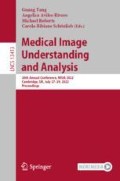Abstract
Class imbalance in various forms is a common challenge in machine learning (ML) applied to medical imaging. One of these forms is the presence of low probability, but unsurprising, tissue abnormalities as a result of e.g. implants and surgery. Assessments from automated methods can be impeded if the ML system cannot address these abnormalities. A context where this issue arises is segmentation of lesions within the liver when postoperative scans are possible inputs to the model, since surgical clips and postoperative seromas can distort measures such as future liver remnant volume if they are not correctly identified. To this end, we developed a deep learning segmentation model with classes that expliciltly include surgery-related structures: liver parenchyma, lesions, surgical clips, and postoperative seromas. Given a heavy class imbalance in this task, we deployed an asymmetric focal loss function and hysteresis thresholding post-processing. We applied our model to T1-weighted MRI data, reporting average Dice scores of 0.96, 0.57, 0.71, and 0.84 for the four classes, respectively. Finally, we tested the model’s potential in a semi-automatic workflow, finding a user-interaction speedup and an increased inter-rater agreement compared to fully manual delineations. To our knowledge, this is the first study to investigate an automated lesion segmentation model for postoperative MRI with both surgical clips and seromas as explicit classes, and the first work to explore an asymmetric focal loss function for segmentation in liver cancer.
Access this chapter
Tax calculation will be finalised at checkout
Purchases are for personal use only
References
Adam, R., Kitano, Y.: Multidisciplinary approach of liver metastases from colorectal cancer. Annal. Gastroenterological Surg. 3(1), 50–56 (2019). https://doi.org/10.1002/ags3.12227
Antonelli, M., et al.: The Medical Segmentation Decathlon, June 2021
Arya, Z., Ridgway, G., Jandor, A., Aljabar, P.: Deep learning-based landmark localisation in the liver for couinaud segmentation. In: Papież, B.W., Yaqub, M., Jiao, J., Namburete, A.I.L., Noble, J.A. (eds.) MIUA 2021. LNCS, vol. 12722, pp. 227–237. Springer, Cham (2021). https://doi.org/10.1007/978-3-030-80432-9_18
Beichel, R., Bischof, H., Leberl, F., Sonka, M.: Robust active appearance models and their application to medical image analysis. IEEE Tran. Med. Imaging 24(9), 1151–1169 (2005). https://doi.org/10.1109/TMI.2005.853237. https://pubmed.ncbi.nlm.nih.gov/16156353/
Ben Cohen, A., Diamant, I., Klang, E., Amitai, M., Greenspan, H.: Automatic detection and segmentation of liver metastatic lesions on serial CT examinations, p. 903519, March 2014. https://doi.org/10.1117/12.2043718
Canny, J.: A computational approach to edge detection. IEEE Trans. Pattern Anal. Mach. Intell. PAMI-8(6), 679–698 (1986). https://doi.org/10.1109/TPAMI.1986.4767851
Goehler, A., et al.: Three-dimensional neural network to automatically assess liver tumor burden change on consecutive liver MRIs. J. Am. College Radiol. 17(11), 1475–1484 (2020). https://doi.org/10.1016/j.jacr.2020.06.033
Hashemi, S.R., Mohseni Salehi, S.S., Erdogmus, D., Prabhu, S.P., Warfield, S.K., Gholipour, A.: Asymmetric loss functions and deep densely-connected networks for highly-imbalanced medical image segmentation: application to multiple sclerosis lesion detection. IEEE Access 7, 1721–1735 (2018). https://doi.org/10.1109/ACCESS.2018.2886371
Juanpere, S., Perez, E., Huc, O., Motos, N., Pont, J., Pedraza, S.: Imaging of breast implants-a pictorial review. Insights Imaging 2(6), 653 (2011). https://doi.org/10.1007/S13244-011-0122-3, /pmc/articles/PMC3259319/ /pmc/articles/PMC3259319/?report=abstract https://www.ncbi.nlm.nih.gov/pmc/articles/PMC3259319/
Li, Z., Kamnitsas, K., Glocker, B.: Analyzing overfitting under class imbalance in neural networks for image segmentation. IEEE Trans. Med. Imaging 40(3), 1065–1077 (2020). https://doi.org/10.1109/TMI.2020.3046692
Lin, T.Y., Goyal, P., Girshick, R., He, K., Dollár, P.: Focal Loss for Dense Object Detection, August 2017
Ma, J., Chen, J., Ng, M., Huang, R., Li, Y., Li, C., Yang, X., Martel, A.L.: Loss odyssey in medical image segmentation. Med. Image Anal. 71, 102035 (2021). https://doi.org/10.1016/j.media.2021.102035
Mole, D.J., et al.: Study protocol: HepaT1ca - an observational clinical cohort study to quantify liver health in surgical candidates for liver malignancies. BMC Cancer 18(1), 890 (2018). https://doi.org/10.1186/s12885-018-4737-3
Mole, D.J., et al.: Quantitative magnetic resonance imaging predicts individual future liver performance after liver resection for cancer. PLOS ONE 15(12), e0238568 (2020). https://doi.org/10.1371/journal.pone.0238568
Suzuki, K., et al.: Quantitative radiology: automated CT liver volumetry compared with interactive volumetry and manual volumetry. Am. J. Roentgenol. 197(4), W706–W712 (oct 2011). https://doi.org/10.2214/AJR.10.5958
Villanueva, A.: Hepatocellular Carcinoma. New England J. Med. 380(15), 1450–1462 (2019). https://doi.org/10.1056/NEJMra1713263
Vivanti, R., Joskowicz, L., Lev-Cohain, N., Ephrat, A., Sosna, J.: Patient-specific and global convolutional neural networks for robust automatic liver tumor delineation in follow-up CT studies. Med. Biol. Eng. Comput. 56(9), 1699–1713 (2018). https://doi.org/10.1007/s11517-018-1803-6
Wang, S., Liu, W., Wu, J., Cao, L., Meng, Q., Kennedy, P.J.: Training deep neural networks on imbalanced data sets. In: 2016 International Joint Conference on Neural Networks (IJCNN), pp. 4368–4374. IEEE, July 2016. https://doi.org/10.1109/IJCNN.2016.7727770
Yushkevich, P.A., et al.: User-guided 3D active contour segmentation of anatomical structures: significantly improved efficiency and reliability. NeuroImage 31(3), 1116–1128 (2006). https://doi.org/10.1016/j.neuroimage.2006.01.015
Author information
Authors and Affiliations
Corresponding author
Editor information
Editors and Affiliations
1 Electronic supplementary material
Below is the link to the electronic supplementary material.
Rights and permissions
Copyright information
© 2022 The Author(s), under exclusive license to Springer Nature Switzerland AG
About this paper
Cite this paper
Vogt, N. et al. (2022). A Deep-Learning Lesion Segmentation Model that Addresses Class Imbalance and Expected Low Probability Tissue Abnormalities in Pre and Postoperative Liver MRI. In: Yang, G., Aviles-Rivero, A., Roberts, M., Schönlieb, CB. (eds) Medical Image Understanding and Analysis. MIUA 2022. Lecture Notes in Computer Science, vol 13413. Springer, Cham. https://doi.org/10.1007/978-3-031-12053-4_30
Download citation
DOI: https://doi.org/10.1007/978-3-031-12053-4_30
Published:
Publisher Name: Springer, Cham
Print ISBN: 978-3-031-12052-7
Online ISBN: 978-3-031-12053-4
eBook Packages: Computer ScienceComputer Science (R0)

